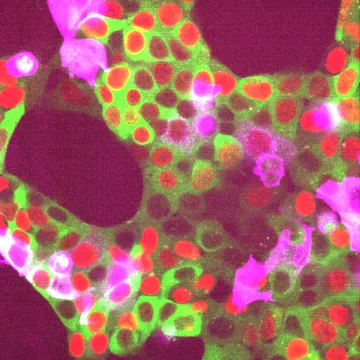NIH research grant awarded to UArizona College of Science to decipher relationships between synapse function and growth control pathways

Dr. Martha Bhattacharya, Associate Professor of Neuroscience (Photo credit: Molly Condit / Great Bear Media)
The recent competitive renewal of a $2 million grant from the National Institutes of Health (NIH) Research Project Grant Program (R01) will clarify a critical control mechanism that maintains synaptic structure and function. The protein being investigated, TMEM184B, is implicated in a poorly understood pediatric nervous system disorder. The project will determine the underlying causes of disruption at the biochemical, cellular, and functional levels, which will ultimately inform how synapses grow as animals develop and how this may go awry in neurodevelopmental diseases.
The research into TMEM184B is led by Dr. Martha Bhattacharya, Associate Professor in the Department of Neuroscience, Dr. Thomas Tomasiak, Assistant Professor in the Department of Chemistry & Biochemistry (CBC), and Dr. Tarjani Thaker, a newly hired Assistant Professor also in CBC at the University of Arizona.
“My lab is excited to have an opportunity to ask mechanistic questions about how this conserved protein and its pathway underlie nervous system disruption and disease," said Dr. Bhattacharya. "By understanding the basic science of how neurons develop and communicate, using tools of genetics, cell biology, and biochemistry, we can reveal commonalities that are essential to maintaining nervous system function throughout life."
Synaptic disruption is a prelude to and often a primary cause of neurological disease, but there are few strategies to correct malfunctioning synapses, even if they occur early in life. Growth control pathways, such as those that promote protein and lipid synthesis, regulate synaptic size and shape that in turn ensures efficient function and plasticity. Disruption of growth control pathways can lead to many types of disorders in children, with some of these affecting the brain. However, the relationship between growth control pathways and synaptic function is not clear.

This image shows human cultured cells where the TMEM184B protein (labeled pink) is being expressed. Green is a growth pathway indicator, and red labels cell nuclei. The Bhattacharya lab uses fluorescently labeled proteins to watch activation of growth control pathways in the presence of normal or altered TMEM184B protein variants. (Image courtesy of Zachary Yahiku, a PhD student in the Bhattacharya lab.)
The 7-pass endosomal membrane protein TMEM184B is important to ensure appropriate synaptic structure and function across species; accordingly, its loss causes extra synaptic branches, swollen nerve terminals, and increased excitability. Working with clinicians across the US and around the world, Dr. Bhattacharya found that changes in conserved amino acids in the TMEM184B protein are linked to nervous system disruptions including microcephaly (small brain size), intellectual disability, and epilepsy. TMEM184B mutations can also disrupt the axons that cross between brain hemispheres in a structure called the corpus callosum. While TMEM184B genetic disruptions are rare, the disorders produced by its disruption are common, suggesting an intersection with key neurological pathways.
The new grant will attempt to define how the TMEM184B protein fits in with pathways known to promote growth and development. By combining computer-based simulations, protein and cellular studies, and analysis of TMEM184B in both mice and fruit flies (Drosophila melanogaster), Dr. Bhattacharya’s research seeks to reveal how TMEM184B protein function ensures synaptic size, proper neuronal development, and neuronal electrical properties. Not only will this improve understanding of the rules governing synaptogenesis, but it will clarify the disruptions that lead to TMEM184B-associated human syndromes. Ultimately, the knowledge produced in this work will enable a better classification of TMEM184B-associated disorders with others showing similar symptoms, permitting improved diagnosis and treatment.
"We are extremely thankful to the National Institutes of Health for recognizing the potential impact of this work,” Bhattacharya said.
To learn more about the research being conducted in Dr. Martha Bhattacharya’s lab, please click here.

